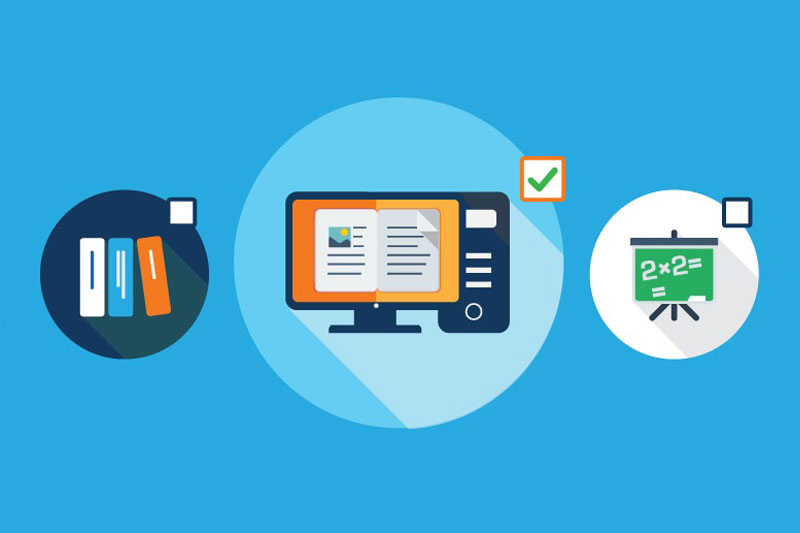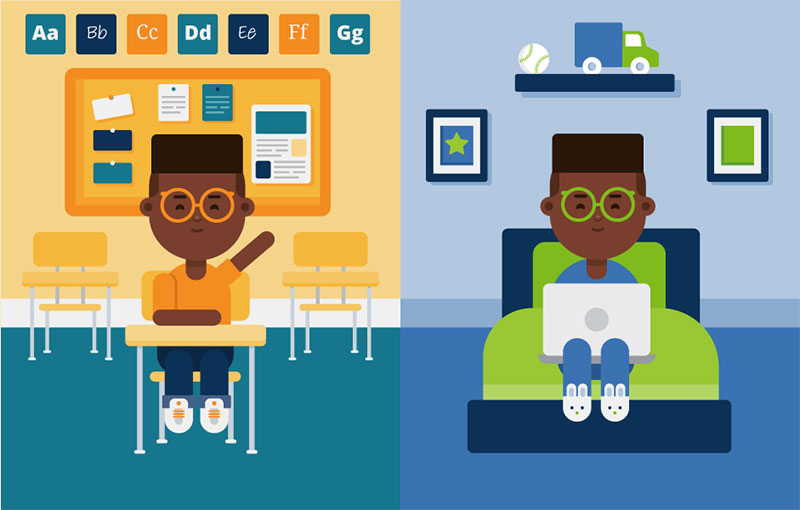How schools can use distance education to continue and improve learning
Since the spread of the pandemic caused by the new coronavirus, COVID-19, schools around the world have been closed, which has given a new look at distance education.
The cancellation of all classroom classes for up to two months, as a means of contributing to social isolation and preventing the proliferation of the virus, forced schools to seek distance education.
Although face-to-face classes are essential, especially for elementary and high school students, there are several ways in which schools can adapt their teaching schedule to continue education.

Situation of school education in the midst of the COVID-19 crisis
Guided by WHO, one of the first measures taken by governments was to promote social isolation, indicated as the most effective method to contain the proliferation of the new coronavirus.
As a result, schools were promptly closed for a minimum period of thirty days, preventing not only students from contracting the virus, but also acting as transmitters for parents and people included in the risk group, such as the elderly and other individuals with compromised immune systems.
The whole world has been quarantined and the period of isolation has no definite end date, which has led to a new dilemma: how to prevent the school year from being lost?
The solution found was distance education, making use of computers and complementary activities to continue the learning of children and adolescents.
– 8 things you need to know about distance education
However, not all students have access to quality computers and the internet, especially those in situations of greater social vulnerability.
Another problem is maintaining the concentration of younger children and having time to help their studies, as many parents are working at home or still need to leave.
As we said, these problems are more serious in places with less development and, according to Unicef, 154 million students are without classes in Latin America and the Caribbean.
The entity warns that the situation may extend, and there is a risk of permanent school dropout.
Preventing this forecast from being fulfilled requires great efforts from the governments, but, from an educational point of view, there is much that school administrators and teachers can do to contribute to distance education.
Tips for using distance education
First, don’t panic. Take a deep breath and realize that while implementing a distance education system may seem daunting or less effective than a traditional classroom, everything is adaptable.
Try to let go of all the defenses you have and understand that this is a way to meet the needs of your students during this unprecedented time.
Take this situation as an opportunity to think about how we can extend learning outside the classroom walls, making it reach those who need it.
To help, we have prepared some tips on how it is possible to make distance education more effective and enjoyable for all parties involved, considering the different age groups of students.
Reading aloud on video (Early Childhood and Lower Elementary)
One way to involve families and students at home, especially children, is to read aloud through video.
– Tips for speaking well on video
As an educator, you can choose a book that connects to learning and create a video by reading it. This teaching method allows you to take breaks, highlight interesting points, and ask questions for students to answer as a lesson.
Reading can be done through recorded or live video, using platforms such as Facebook, Instagram or YouTube.
– Learn how to record videos at home
Teachers and administrators who do this often organize a live event on the school’s social media sites and parents are notified when it will air.
If you do not want to do the reading live, no problem, record the video in advance and host it on the e-Learning platform adopted by the school.
– What is an e-Learning platform
Videos, photos and online journal (Elementary)
Anyone who has worked in elementary schools knows that children are familiar with the technology, but that does not make them experts in technology.
It is also important to highlight that young people and children tend to adopt a passive attitude towards the content they consume on the internet. But when it comes to study, it is important that the student is more active, engaged with his own learning.
For this reason, digital lessons at home need to be friendly, simple to perform and interesting for the student and their families.
Promoting interactive activities, involving practical tasks in the student’s routine, is a great way to attract his attention and involve him with the study.
Propose an online journal. Ask students to write down facts, take photos, make videos and type in questions and answers for anything they find interesting in their daily lives.
This activity allows you to insert content in a light way, prompting students to make digital records of practical experience.
You can ask, for example, that the student:
- Make a video of himself reading a book.
- Take photos of different shapes in his home and identify them.
- Take a picture of a math spreadsheet and record an audio overlay to explain how he solved the problem.
- Start a blog and write down his experiences at home.
- Make a video tutorial performing an experiment or solving a math problem.
Screencasts (Middle and High School)
Many high school teachers are already used to using a learning management system, such as Coursify.me. In such cases, creating online classes is nothing new.
For many, however, distance learning is something new. For this reason, we advise the production of screencasts as one of the easiest ways to share content and guidance with your students.
A screencast is a video that includes the content that appears on the computer screen (records your screen directly), as well as your voice. It is a fabulous way for students to see what you see, follow your explanation and still hear your voice, allowing them to feel connected.
There are several free software on the internet that allow you to do this, Screencastify, for example, being a great tool to help you accomplish this task.
– See which are the best screen recorders
Screencastify is a Google Chrome extension that not only allows the quick creation of these videos, but is also automatically synchronized with your Google Drive account and is fully integrated with Google Classroom.
With this type of software you can record tutorial videos on more complex subjects, producing an explanatory step by step for your students.
– Record video tutorials: tips for getting the best result
If you are recording a video of the Google Slides presentation, consider turning on the Closed Caption ability to help students who have a hearing problem.
Focus on blended learning

When considering distance education, school districts should consider whether the student and family population have computers and reliable access to the Internet, before employing fully digital education.
As we know that this is not yet a reality for everyone, best practices suggest that hybrid teaching be adopted, combining digital and analog tasks, in order to ensure that all students have access to activities and are able to follow the school curriculum.
It is important to highlight its hybrid concept, that is, a methodology that adequately aggregates teaching through technological means, without replacing, but integrating with the traditional format.
Blended Learning uses technology not only to supplement, but to transform and improve the learning process.
– Blended learning: a combination of online and face-to-face learning
Why use a distance education platform
There are many different activities that you can offer your students to make distance education pleasant and effective.
But, for that, the school needs to adopt a e-Learning platform that provides all the resources necessary for virtual learning.
The good news is that platforms that act as a Learning Management System (LMS), are ready to use and offer a very low cost compared to the purchase and implementation of standard software.
-– Whats is a Learning Management System
In addition, a platform in the SaaS model (software as a service), developed specifically for this purpose, has advantages such as being an easy-to-use tool, with a friendly interface, integration with other information systems and possibility to be accessed from any device with internet access.
The main resources that a complete online teaching platform like Coursify.me have are:
- Creation and management of courses;
- Registration and management of students;
- Integration with other platforms, such as Dropbox and YouTube;
- Tools for working with videos;
- Tools to distribute files and other materials necessary for teaching;
- Monitoring the student’s progress;
- Tools that allow the interaction with students.
Other than that, there is still the possibility of organizing classes in modules, lessons or in whatever way you think is best to facilitate learning.
The Coursify.me allows the school to host and access materials developed in a variety of different formats, such as Office documents, videos and applications.
To find out more,visit our website, test the platform and start implementing distance education in your school right now.

